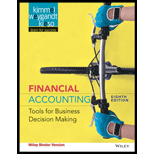
Concept explainers
a)
First-in First-Out method (FIFO): In First-in-First-Out method, the costs of initial purchased items are sold first. The value of the ending inventory consists of the recent purchased items.
Last-in First-Out method (LIFO): In Last-in-First-Out method, the costs of last purchased items are sold first. The value of the closing stock consists of the initial purchased items.
Straight-line
Declining-balance depreciation:
It is an accelerated method of depreciation under which the depreciation declines in each successive year until the value of asset becomes zero. Under this method, the book value (original cost less
To determine: Use of FIFO instead of LIFO
b)
Use of 6-year life instead of 9-year life machinery.
c)
To determine: Use of depreciation method
Want to see the full answer?
Check out a sample textbook solution
Chapter 13 Solutions
Financial Accounting 8th Edition
- Given the following cost and activity observations for Smithson Company's utilities, use the high-low method to calculate Smithson's fixed costs per month. Cost Machine Hours January $3,080 14,719 February $2,669 10,205 March $2,806 12,138 April $3,573 18,476 A. $2,669 B. $3,032 C. $1,554 D. $1,471arrow_forwardCan you explain this general accounting question using accurate calculation methods?arrow_forwardcalculate the unit costarrow_forward
- The output of a company's assembly department during the period consists of 32,000 units completed and transferred out, and 18,000 units in ending Work in Process that were 40% complete as to materials and conversion costs. The beginning inventory was 15,000 units that were 20% complete as to materials and conversion costs. Under the weighted-average method, what are the equivalent units of production for materials? a. 39,200 b. 32,000 c. 7,200 d. 41,000arrow_forwardCan you help me solve this general accounting problem with the correct methodology?arrow_forwardwhat was the change in inventory over the year ??arrow_forward
 College Accounting, Chapters 1-27AccountingISBN:9781337794756Author:HEINTZ, James A.Publisher:Cengage Learning,
College Accounting, Chapters 1-27AccountingISBN:9781337794756Author:HEINTZ, James A.Publisher:Cengage Learning, Survey of Accounting (Accounting I)AccountingISBN:9781305961883Author:Carl WarrenPublisher:Cengage Learning
Survey of Accounting (Accounting I)AccountingISBN:9781305961883Author:Carl WarrenPublisher:Cengage Learning Cornerstones of Financial AccountingAccountingISBN:9781337690881Author:Jay Rich, Jeff JonesPublisher:Cengage Learning
Cornerstones of Financial AccountingAccountingISBN:9781337690881Author:Jay Rich, Jeff JonesPublisher:Cengage Learning Financial Accounting: The Impact on Decision Make...AccountingISBN:9781305654174Author:Gary A. Porter, Curtis L. NortonPublisher:Cengage LearningPrinciples of Accounting Volume 1AccountingISBN:9781947172685Author:OpenStaxPublisher:OpenStax College
Financial Accounting: The Impact on Decision Make...AccountingISBN:9781305654174Author:Gary A. Porter, Curtis L. NortonPublisher:Cengage LearningPrinciples of Accounting Volume 1AccountingISBN:9781947172685Author:OpenStaxPublisher:OpenStax College Auditing: A Risk Based-Approach (MindTap Course L...AccountingISBN:9781337619455Author:Karla M Johnstone, Audrey A. Gramling, Larry E. RittenbergPublisher:Cengage Learning
Auditing: A Risk Based-Approach (MindTap Course L...AccountingISBN:9781337619455Author:Karla M Johnstone, Audrey A. Gramling, Larry E. RittenbergPublisher:Cengage Learning





